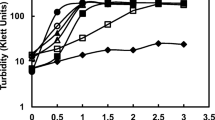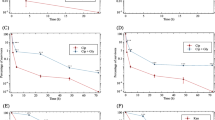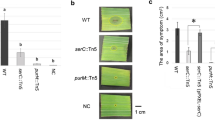Abstract
The pathogenicity of a wild type strain and a nutritional mutant ofCladosporium cucumerinum was not changed after prolonged culturing on media containing D-serine, L-threo-β-phenylserine or DL-β-aminobutyric acid. Growth of the wild type strain was inhibited by D-serine, whereas the mutant was found able to utilize this compound. Both strains were able to grow in a medium containing L-threo-β-phenylserine as sole source of nitrogen. These results support the hypothesis that the increase in resistance to both strains of cucumber seedlings treated with the compounds just-mentioned is not due to a direct inhibition of the development of the pathogen.
Samenvatting
De pathogeniteit van een “wild type” stam en een mutant vanCladosporium cucumerinum werd niet beïnvloed door kweken op media, die D-serine, L-threo-β-phenylserine of Dl-β-aminoboterzuur bevatten. De groei van de “wild type” stam werd door D-serine geremd, terwijl de mutant deze verbinding als stikstofbron kon gebruiken. Beide stammen waren in staat te groeien in een medium dat alleen L-threo-β-phenylserine als stikstofbron bevatte. Deze resultaten steunen de hypothese dat de toename in resistentie van komkommerkiemplanten tegen beide stammen, veroorzaakt door behandeling met de genoemde verbindingen, niet het gevolg is van een directe remming van de ontwikkeling van het pathogeen.
Similar content being viewed by others

References
Andel, O. M. van, 1958. Investigations on plant chemotherapy. II. Influence of amino acids on the relation plant-pathogen. Tijdschr. PlZiekt. 64: 307–327.
Andel, O. M. van, 1962. Growth regulating effects of amino acids and dithiocarbamic acid derivatives and their possible relation with chemotherapeutic activity. Phytopath. Z. 45: 66–80.
Emerson, R. L., Puziss, M. and Knight, S. G., 1950. D-amino acid oxidase of molds. Archs. Biochem. Biophys. 25: 229–308.
Horowitz, N. H., 1944. The D-amino acid oxidase of Neurospora. J. Biol. Chem. 154: 141–149.
Hrushovetz, S. B., 1957. Effect of amino acids on the virulence of Helminthosporium sativum to wheat seedlings. Phytopathology 47: 261–264.
Lowther, R., 1964. Further studies on the physiology of Cladosporium fulvum Ch. and resistance in tomato. Can. J. Bot. 42: 1365–1386.
Williams, F. J., 1965. Antecedent nitrogen sources affecting virulence of Colletotrichum phomoides. Phytopathology 55: 333–335.
Zenk, M. H. and Scherf, H. D., 1964. Verbreitung der D-Tryptophan-Konjugations-Mechanismus im Pflanzenreich. Planta 62: 350–353.
Author information
Authors and Affiliations
Rights and permissions
About this article
Cite this article
van Andel, O.M. Effect of chemotherapeutically active amino acids on pathogenicity and growth of a wild type strain and a nutritional mutant of Cladosporium cucumerinum Ell. et Arth.. Netherlands Journal of Plant Pathology 75, 151–156 (1969). https://doi.org/10.1007/BF02137210
Accepted:
Issue Date:
DOI: https://doi.org/10.1007/BF02137210



